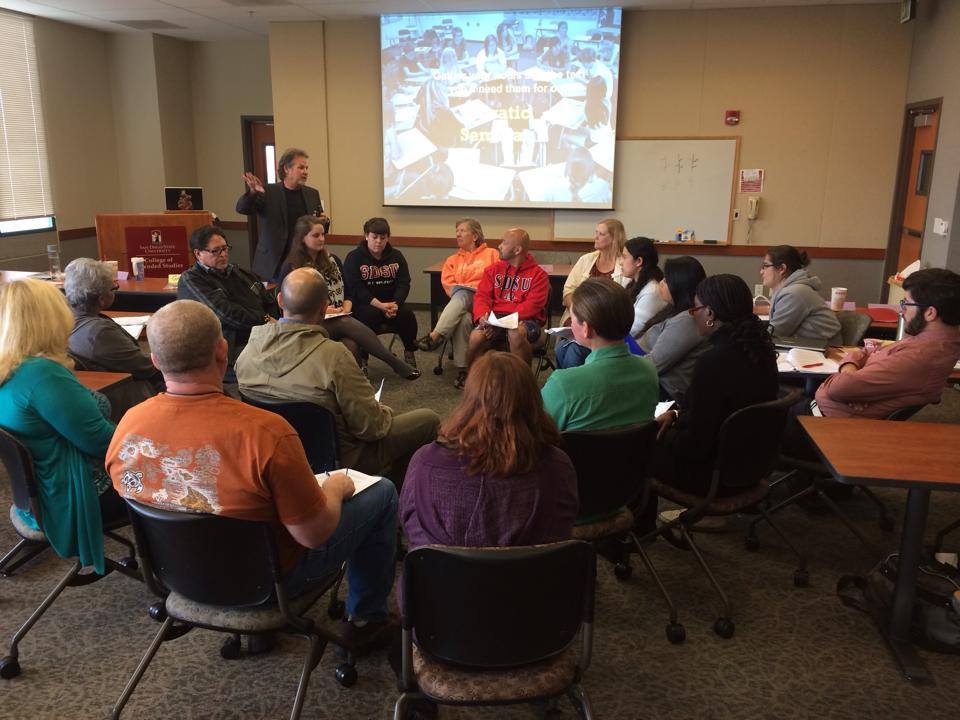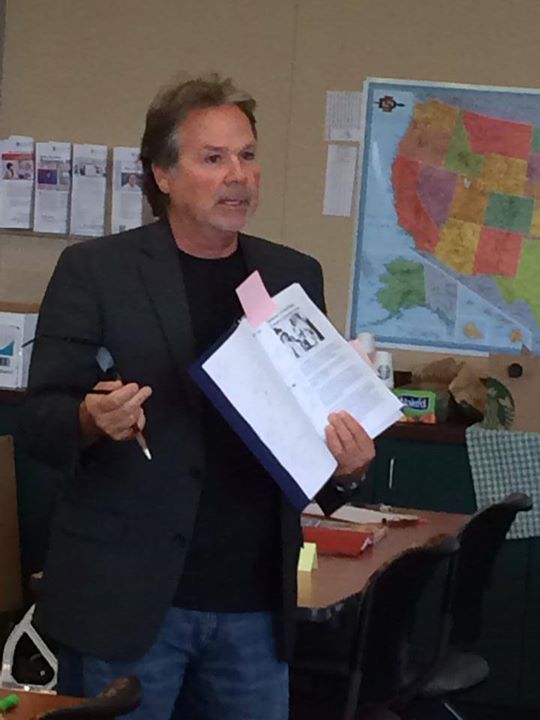Content, Curiosity, and Relationships
 AVID Center
AVID Center  Wednesday, April 8, 2015 at 1:47PM
Wednesday, April 8, 2015 at 1:47PM By Gary Kroesch, AVID Staff Developer
 It was the first day back at La Jolla High after a too-short summer, and I was stumbling through my new class schedule, my mind still on happy days spent on the beach. After lunch, I wandered into Ms. Gloria Moore’s world history class, expecting the same old lectures and counting the minutes before I could grab my board and get back down to the beach.
It was the first day back at La Jolla High after a too-short summer, and I was stumbling through my new class schedule, my mind still on happy days spent on the beach. After lunch, I wandered into Ms. Gloria Moore’s world history class, expecting the same old lectures and counting the minutes before I could grab my board and get back down to the beach.
But there was something different about this class. Instead of rows of seats facing forward like every other classroom I had ever been in, this one had the seats arranged in a circle with Ms. Moore at the blackboard. We students sat facing each other across the circle—a strange and somewhat uncomfortable experience at first as we waited for everyone to file in and sit down. Yet form followed function: we were about to get a very different kind of lesson—one in critical thinking.
Ms. Moore was a veteran teacher and very popular with her students. She had figured out how to get the attention and engagement of distracted beach kids like me. Instead of the usual monologue of facts, she sowed ideas in us through a series of open questions that were left hanging in the air for us students to trouble over. She also surprised us all by asserting that our ideas mattered. She encouraged us to voice our own opinions and insights about class assignments, readings, and the primary sources and films we used. She gave us space and permission to ask questions and arrive at our own conclusions.
Like any sport, there were rules of engagement—what she called discussion norms. Ms. Moore guided us on how to engage in the back-and-forth, give-and-take of conversation without throwing fists or insults. We were taught to acknowledge and entertain the ideas of others. Sure, we could disagree, but we had to present logical alternatives based on evidence from our textbooks and other materials. We could not have parallel conversations where one student had a comment and another student talked over him. We had to stick to the topic and acknowledge what had been said before adding something.
Ms. Moore’s methods date back to Greece of the 5th Century B.C. when Socrates first introduced a new way of thought and learning. Instead of top-down wisdom, Socrates’ approach emphasized audience participation and original thought—even democracy—from the bottom up. In a way, Socrates was letting audience members educate themselves through a series of questions and answers among peers. The Socratic method is a search for truth arrived at by questioning widely-held assumptions. Critical thinking and Socratic discussions go hand in hand.
I remember one discussion in Ms. Moore’s class about some guiding documents from early civilizations. What is most interesting or surprising about these primary sources? How were these documents alike and how were they different? What do you think if we lived by these ideas? What questions would you like to ask ancient scribes to better understand these original sources?
Ms. Moore would probe the class and cleverly lead the discussion by occasionally posing such questions. She always found some way to stimulate our interests—in this case, by contrasting the documents we were studying with some of the ideas of Confucius. Ms. Moore always made learning relevant to today; and, clearly, she had a lasting impact on me.
To start a Socratic Seminar, students are seated in a circle facing each other to participate in the dialogue. Open-ended prompts should be used to stimulate extended, thoughtful discussion. A good prompt raises important questions in students’ minds—questions for which there are no right or wrong answers. The role of the teacher is to keep the discussion focused on the text and the topic. Participants respond to the question and support their responses, citing specific passages from the reading or film. Students do not typically raise their hands and wait to be called on. The goal is to have an “organic” conversation that models authentic academic discourse rather than answering a set of questions. Students learn to listen actively to their fellow participants, sharing ideas and questions while searching for evidence. After the seminar, the instructor should give students a writing prompt that will allow them to summarize the main ideas or a personal reflection about new thoughts, ideas, or questions they have about the discussion. At the end of a successful Socratic Seminar, students should leave with more questions than they brought with them.
My first Socratic Seminar made me appreciate Ms. Moore’s skill. Like the students I teach today, I was learning a new skill of facilitating a discussion to keep the conversation going and challenge others to give examples.
Recently, our class was studying slavery in America, and I wanted to find a primary source that would be interesting and evocative enough to touch the emotions of 16-year-olds. I discovered an article from The New York Tribune in 1847 by Horace Greeley. He wrote a first-hand account of witnessing a slave auction in Charleston, South Carolina. The horrifying personal details were more compelling than any recitation of historical facts. It’s something the kids would remember and think about.
Living in the information age, we’re all constantly deluged by myriad unrelated facts and opinions disguised as facts that are really just someone else’s point of view. Students are often trained to absorb information, but not to parse it, evaluate it, or connect the dots for themselves. Teaching other people’s strongly held beliefs top down doesn’t always leave room for young people to develop their own ideas and critical thinking habits.
The long-term success of a well-prepared and well-rounded student must, ultimately, be built upon a foundation of critical thinking and disciplined “habits of mind” for success in school—or life itself. Otherwise, you’ll always be held captive by the opinions of others.
“I know that I know nothing,” Socrates said.
To that we can add: “But I know how to go about finding just about anything.” Gary Kroesch is a teacher, college instructor, and AVID staff developer. He is currently a teacher at San Diego State University. For more than 15 years, Gary was the Director of the History-Social Science Project at the University of California, San Diego, managing and directing teacher workshops and professional development with university faculty. He is a national consultant and trainer of trainers for AVID Center. Gary has authored AVID’s history-social science curriculum and contributed to the new AVID for Higher Education curriculum. Gary Kroesch is co-author of two books- What We Need to Face in American Education and Eye of the Beholder: Looking at Primary Sources.
Gary Kroesch is a teacher, college instructor, and AVID staff developer. He is currently a teacher at San Diego State University. For more than 15 years, Gary was the Director of the History-Social Science Project at the University of California, San Diego, managing and directing teacher workshops and professional development with university faculty. He is a national consultant and trainer of trainers for AVID Center. Gary has authored AVID’s history-social science curriculum and contributed to the new AVID for Higher Education curriculum. Gary Kroesch is co-author of two books- What We Need to Face in American Education and Eye of the Beholder: Looking at Primary Sources.
Kroesch can be contacted at gkroesch@gmail.com.
Reader Comments (1)
Gary's story and analysis are "spot on" and the keys for me his awareness that "organic conversation" is superior to the teacher controlled information blast we call lectures (see"The Problem with Lectures" online). Educators are taught to expel masses of information - much of which is forgotten - without student autonomy to make sense, use or play with the information themselves. Play needs to be a core lens for lesson plans as it is the main process for real, enduring learning and memory.
Finally, Gary gets that lessons are best framed or accompanied by emotional elements that engage the interest and focus of the students, "I discovered an article from The New York Tribune in 1847 by Horace Greeley. He wrote a first-hand account of witnessing a slave auction in Charleston, South Carolina. The horrifying personal details were more compelling than any recitation of historical facts." The key is the "compelling" nature of the text he chose. Too often what teachers do out of fear is give watered down or generic material that is by nature boring.
So, student-centered and more constructivist activities and strategies along with emotionally novel or compelling texts or questions create experiences worth engaging and worth remembering.